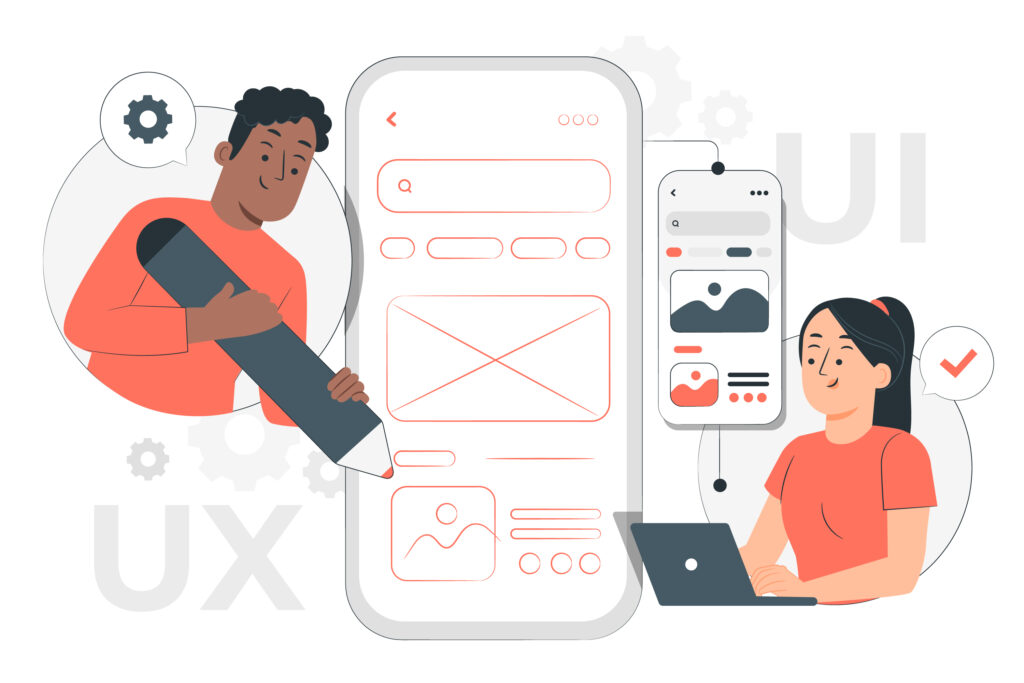A website’s conversion rate determines its success or failure. Poor conversion rates will cause your business to struggle to stay afloat, while good conversion rates will increase your sales and revenue.
Your site’s user experience is one of the most significant factors affecting conversions, so it’s essential to examine and master it.
A user experience refers to everything your customers, leads, or visitors experience as they navigate and interact with your website. Ensure your site’s user experience is as seamless as possible, without unnecessary friction. The friction can be slow loading speeds, poor navigation, low-quality images, or anything that results in a negative experience.
What can you do to avoid negative user experience, and why does it matter for your website conversion and retention rate? Let’s discuss this and much more in today’s article.
Table of Contents
What is Meant By UX Design?
UX design is the process to design a physical or digital product that offers the best experience to the person who uses or interacts with these products. We can refer to these products as websites, mobile apps, video games, or computer applications.
The ultimate goal of user experience (UX) is to provide customer satisfaction and promote loyalty through ease of use when interacting with the system.
In the context of a website which will be our main topic of discussion, UX refers to how a visitor interacts with the website, whether he likes it or dislikes it while navigating through.

Having a good UX design obviously means that users will likely stay and enjoy their time on a website. If their last visit was excellent, they might return to purchase more products or learn something new. The same is true for vice versa.
Whenever you are designing the UX of a website, know the followings:
- Users want simplicity and clarity
- Your website success rate will ultimately depend on UX design
- Know your target audience, see what your competitors do, and take some inspiration and design something better.
Remembering all these things helps you in making the best website design that provides a better customer experience and helps in increasing conversion and customer retention as well.
How Does a Good UX Design Help a Business?
Now that you understand the basic definition of UX design, let’s discuss why it matters so much for your website.
Increase Conversion Rates
Obviously, the first and foremost purpose of UX design is to increase the conversion rate on a website. Any website that’s easy to navigate and understand has a higher likelihood of converting customers into purchasing products or services that are offered.
On the other hand, if a website has a complex design, slow loading speed, and does not provide relevant information to users it will have a low conversion rate. The user is most likely to go to a competitor’s website to get what they want, and nobody wants that.

Profitable Growth
Continuing from the first point, if you have a high conversion rate, you will also have high-profit margins, which is every business’s ultimate goal. The UX design of your website definitely plays an important part here.
Reduced Acquisition Costs
The cost of acquiring new customers through marketing, advertising, and PPC is very high. That’s why retaining existing customers reduces these costs greatly. The budget that was to be used for marketing can be utilized elsewhere to expand the business or add new products/services.
A Higher Level of Customer Satisfaction
A business that focuses on retaining customers and listens to their feedback and concerns will have better customer satisfaction. This helps to establish a good reputation for the company as well.
Easy Word-of-Mouth Marketing
Higher customer retention gives you word-of-mouth marketing. It’s a no-brainer that happy customers are more than likely to recommend your website to others if they feel satisfied with the services.
Enhance Your Website’s Visibility.
Good UX design is also an important part of SEO, specifically technical SEO. A site with a good UX design automatically ranks on top of search results and gets organic traffic because, for Google, user experience (UX) is an important ranking factor.

Makes First Good Impression
You may have heard a famous saying ‘First impression is last impression’. The same applies to the website design of your website. The first interaction of a user with your website matters quite a lot. If they like it, they might stay, if not, they might never return.
So, the first order of the day is to create a visually appealing website that is consistent with your brand theme. So, if you haven’t got an e-commerce logo for your brand, then it’s time to do so.
Remember it takes merely a few seconds to form this first impression so be careful not to do anything wrong that makes this impression negative.
Gives a Competitive Advantage
Having a better user experience automatically gives you an advantage over competitors.
Remember, users always open several websites at once to find the information they want. The information may be similar on all the websites, but which has the best UX design will be preferred among these sites.
That’s why you can stand out among competitors by prioritizing user experience (UX), and a user will keep visiting your site.
Helps in Getting Mobile Customers
If we are optimizing a site for user experience (UX), then it’s evident we must also optimize it for mobile devices. Mobile devices account for more than half of global traffic, and to retain and convert this traffic, we must have a responsive website design that suits mobile users.
Having a mobile-centered UX design not only helps to increase sales but also helps in gaining new customers that only use mobile devices to search for anything.
How To Increase Customer Retention Through UX Design?
Now let’s talk about some helpful strategies to implement in UX design on your website that help in customer retention:
Collect and Analyze User Data
Enhancing your website’s user experience (UX) design begins with understanding how users interact with it. Insights such as time spent on a page, bounce rate, and click-through rate (CTR) can offer valuable clues about how engaging your site is to users.
Harness the power of Capturly to gain a deeper understanding of user interactions. This can include crucial metrics such as time spent on your site, which pages capture user attention the most, and many others. By leveraging this information, you can pinpoint areas in need of improvement.
Capturly allows you to glean insights not only from raw numbers but also from visitor behavior patterns. The heatmap feature offers a consolidated view of all clicks and scrolls that occur on your site, providing a visual representation of user engagement.
Moreover, session replays enable you to trace the journey of individual users, offering you a granular view of user behavior.
This powerful tool simplifies the task of detecting UX design issues by providing a comprehensive analysis of user behavior. With Capturly, elevating the user experience has never been easier!
Understand What Your Audience Likes and What Not
Always design a website by considering your target audience. Ask yourself what they want on your website and how they want it. Answer the following question to know what your audience wants.
- What are the Internet habits of your audience, and what do they like most?
- How does your website provide a solution to their problem
- What are your competitors, and what are they doing?
You can also include demographics and computer literacy in these questions. Your next step should be to plan how to make your site’s experience easy and enjoyable for your audience.
Provide Clear Navigation
A website’s navigation system is a very important UX component. The navigation system allows users to browse through different website sections easily to find relevant information.
To enhance user experience design a dynamic website with clearly defined paths that users can easily follow. Approximately 76% of users say they can locate information easily on a website with the essential elements.

The better the navigation system is on a website, the more likely the user will stay on it for a longer period. They will likely make more purchases as they browse more.
Make Your Main Menu Simpler
A common mistake many businesses make is overcrowding their main menu with too many options. Users might get confused due to this practice and face difficulty finding what they want.
Limit the number of menu choices to five or six to make it easier for people to locate what they are looking for. If the user wants to return to the main menu allow them to do so by clicking on your brand logo design in the corner of the website.
Always Write high-quality and Informative Content
Writing and uploading high-quality content on a regular basis keeps users engaged, and they return to the website to read more. New content is mostly published in blogs, articles, news, or infographics that provide value to customers.
For instance, you are a SaaS provider of 360-degree solutions for e-commerce businesses. It is advisable to publish regular blogs and whitepapers dealing with eCommerce topics.
Various topics may be discussed, including artificial intelligence in e-commerce marketing or the formula for inventory turnover ratio. Providing value to your customers will increase their likelihood of returning to you in the future.
In addition to positioning yourself as an authority in your field, consistently providing quality content will prevent your customers from going to your competitors.
Ensure That Your Website is Mobile-Friendly
Mobile devices account for more than 58% of global web traffic, which is expected to continue to rise. Your website must be optimized for mobile devices to attract and retain customers. The average mobile user expects a web page to load within two to three seconds. A slow-loading site will likely result in potential customers leaving your site and going to a competitor.
Use Google’s Pagespeed insights to test the loading speed of your website. The results of this analysis will indicate which elements are slowing down your website and what improvements need to be made.
Optimizing your mobile site speed can be achieved by enabling image compression and disabling unnecessary add-ons.
Even a second improvement in the speed of your mobile site significantly improves your conversion rate. It is particularly important when users utilize touch gestures rather than buttons to interact with your website on mobile devices.
Include Links that Provide Value.
Including useful links throughout your website, content is an excellent way to provide value to your website visitors. Also, adding valuable links from good websites can improve your domain authority.
Make sure to place the links to the content organically; they must also relate to the rest of your content. The links can be external as well as internal too.
For internal links, be sure to check there aren’t any broken links that you link to, as they can result in a bad user experience.
Internal links provide a convenient way for users to navigate between different sections of your website along with helpful resources too.
For example, in a blog related to how to improve page speed, one external link can be added to ‘mobile page speed check’, or in an e-commerce store, if a person proceeds to buy a product, you can strategically place links to similar products which the user can check out as well.
How Can You Measure UX Design’s Effectiveness?
Now that you have made all the necessary changes for improving and enhancing your website UX how can you be sure that the changes have generated positive results? Here are a few ways to measure your UX design’s effectiveness.
Analyze the Interaction of Visitors
For an effective website user experience, you must understand how visitors interact with the forms you provide. When testing how your site visitors interact, you can look at a number of factors, but forms are commonly used for communication.

Not only can the form be used to contact us, but it can also be used to get notified of upcoming products, request a quote, and many other things.
There are a lot of websites that ignore the importance of this because they believe that it is an easy win. However, if your form asks for too much information, your visitors may leave your website in the middle.
These practices directly affect the user experience of your website, so be careful.
Usability Testing
You can also conduct usability testing when assessing the effectiveness of a website’s UX, such as asking your website visitors how they feel while navigating through your site. You can usually have a survey form to ask for their feedback. If a user doesn’t like anything, they will surely fill out the form to describe their experience, so always consider their feedback.
You can also ask your close friends, colleagues, and family members to do usability testing. Gather their response and recommendations if they give any.
If possible, ask them to make a purchase and provide feedback to tell them that everything works smoothly. This also gives you an idea of how an actual user will feel.
Time Required to Complete the Task
Another aspect of measuring user experience (UX) is the time required to complete a task on your website. From the name alone, it is evident that the metric gives you detailed information about how long it takes for a user to complete a given task.

The time can be measured in minutes or seconds as well. Various factors influence how long it takes a visitor to complete the same task, which will vary from visitor to visitor.
Users interact with your website differently, causing fluctuations in seconds and minutes. In cases where fluctuations frequently occur on your website, you should examine why it’s taking longer to complete a particular task.
Your Website’s Navigation Structure
Observe how your site visitors navigate your website design when measuring your website’s UX effectiveness.
Many websites can create an appealing design that draws users’ attention. Despite this, the majority of websites do not offer a streamlined navigation system, as a result of which the user experience is poor. The behavior Flow report in Google Analytics shows how a user traverses a website.
See Page Views and Time Spent on A Page
Page views and time spent on a page are also good metrics for evaluating your site’s UX design. Several tools provide these metrics so check on them every month.
Having more page views indicates that your site is very well optimized for user experience and that visitors like what they see.
Conversely, if your data indicates that your website is receiving fewer page views and time spent, then you should examine what needs to be corrected and make appropriate changes. See which pages are getting fewer views and fix the issue.
Bounce rate
Bounce rate is another factor to consider for analyzing UX effectiveness. The bounce rate will determine if the visitors take any action on your web page or not. The higher value it has, the more concerning it is.
Bounce rate is another factor to consider for analyzing UX effectiveness. The bounce rate will determine if the visitors take any action on your web page or not. The higher value it has, the more concerning it is.
Factors like irrelevant content and slow-loading speed can increase bounce rates. If your website has a high bounce rate, you should test every small element to find and fix the root cause.
The best way to reduce bounce rates is to test every website element. These elements include navigation, content, loading speed, scrolling, etc. Even a small flaw in these factors can negatively impact the user experience.
Conclusion
User experience (UX) is crucial in customer retention and website conversion. By prioritizing UX, businesses can create a seamless and enjoyable online journey for their users, leading to higher engagement, increased customer satisfaction, and ultimately improve conversion rates.
A well-designed and user-friendly website enhances credibility, fosters trust, and encourages repeat visits. Investing in UX research, testing, and continuous optimization can yield significant long-term benefits, ensuring that users stay engaged, conversions increase, and the business thrives in the competitive digital landscape.
Don't forget, sharing is caring! :)

